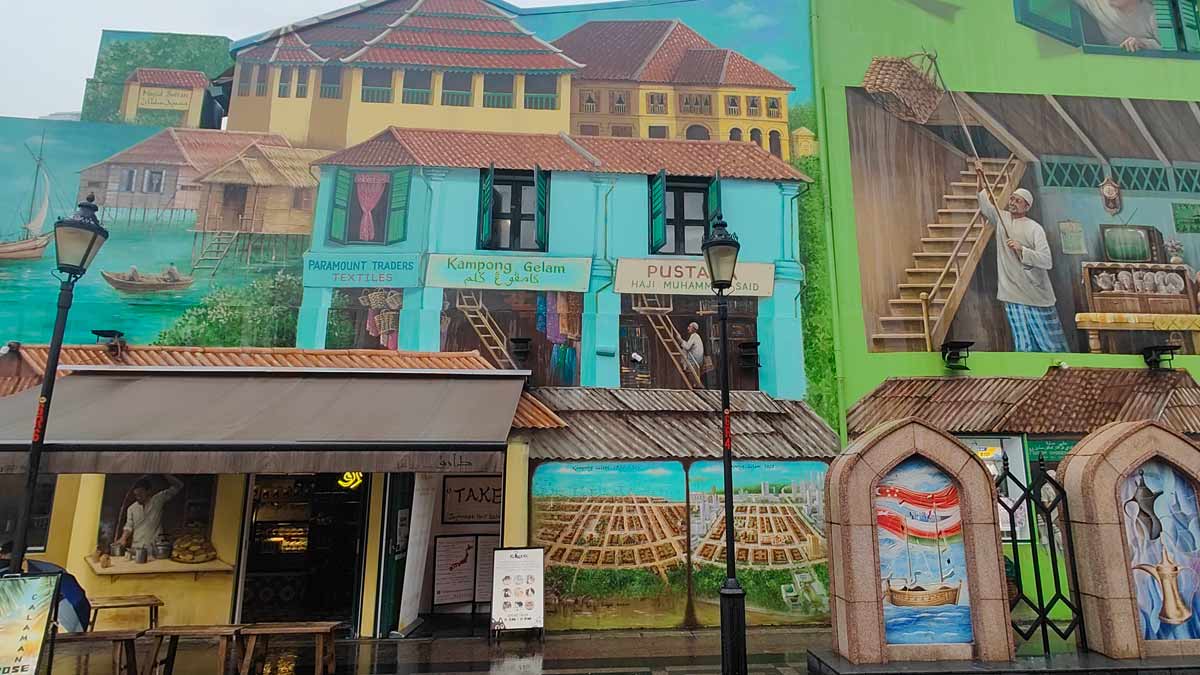A walking tour with a plot twist in Singapore’s Chinatown

I am flanked by imposing high-rise buildings except in front of me. There, I see a slice of the cloudless sky and a lane lined with oblong, orange lanterns. It’s Singapore’s Chinatown, an early 19th-century neighbourhood and one of the city’s oldest. This is where the first Chinese and Indian migrants settled.
Since then, the district has been one of Singapore’s most vibrant historical and cultural hotspots. It features large wall murals, age-old food stalls, a Buddhist temple, newly installed contemporary art, a Hindu temple, a mosque, a church, and a street full of heritage buildings and trinket shops.
There’s so much to learn about and explore in Chinatown that it could be daunting to take it all in at once. But not if you walk around the district while solving a murder mystery. Our guide, David, carries charts, drawings, colourful cards, and pens and pencils for us to solve a fictitious mass murder of five—right here in Chinatown.
The first clue is given to us above the Chinatown metro station, where I first laid eyes on the busy neighbourhood. I had to identify five murder spots on a map, drawing clues from the different logos plastered on the skyscrapers around me.
Once done, we move to the first spot—Pagoda Street—where we meet Aunty Geok. She’s a sculpture of one of the first women migrants in Singapore, making footwear from rubber tyres. She belonged to the Samsui community and was among the first female labourers legally allowed into Singapore in the 1920s. She and her sisters, however, led tough lives, working on construction sites in unsafe and unsanitary conditions.
They lived through one of Singapore’s darkest times. The island was gripped by opium addiction, which destroyed hundreds of perfectly fine men and women. Singapore’s opium trade with India also financed several brothels, fuelled gang wars, and ripped apart the social fabric of the migrant colonies.
Despite the hardships, Aunty Geok managed to spot the murderer and pointed us in the direction he went. She guided us to the Sri Mariamman Temple, Singapore’s oldest Indian shrine, founded in 1827 by Naraina Pillai—a Tamil merchant who arrived with Singapore’s founder, Stamford Raffles, from Penang, Malaysia. Pillai’s temple began as a simple wooden shrine, later rebuilt with bricks in the 1830s. Over time, it was redesigned in the south Indian Dravidian architectural style, featuring a five-tiered ornate gopuram, and inner sanctums dedicated to Mariamman (the goddess of rain and disease prevention), along with deities Durga, Ganesh, and Rama. Interesting fact: the British referred to the gopuram as a "pagoda," which gave the street on which the temple stands its name—Pagoda Street. Years later, however, many Indians moved out of Chinatown to Little India, closer to the Singapore River, where they could access sufficient water for their livestock.
For now though, the temple’s gate gave us our next clue. We had to identify animals such as peacocks, an elephant, and a tiger carved into the gate, solve a puzzle, and earn the next hint.
That clue took us to Lai Chun Yuen, a tea house and Cantonese opera house designed in the 1880s by architect Regent Alfred John Bidwell—who also designed the iconic Raffles Hotel in Singapore.
Right next to the opera house is a series of wall murals depicting the life of old Singapore. In one, a granny sits in the corner of a tiny room sewing a blanket. You can pretend to sit next to her and click a photo that makes it look like you’re in the painting. It’s pretty cool. There are several such murals in Chinatown. In one of them, we had to find a hidden squirrel.
It helped us solve our next clue, which led us to the Chinatown Complex Food Centre—a sprawling hawker zone with 270 stalls offering a variety of foods. We had to locate specific stalls by their number, note their names, and find our final clue within fifteen minutes. The chase took us past some of the best stalls here, including: Lian He Ben Ji Claypot Rice (claypot rice), Hong Kong Soya Sauce Chicken Rice and Noodle (soya sauce chicken rice and noodles), Xiu Ji Ikan Bilis Yong Tau Fu (yong tau foo) and Ann Chin Popiah (popiah).
It was a pleasant surprise to discover that many of these stalls also offer vegetarian and vegan options. We managed to find them all—and catch our murderer—with 10 minutes to spare. Our guide David was quite pleased with our performance, and we realised that the challenge of solving a murder mystery kept us attentive, engaged, and hooked throughout the two-hour walking tour. I am sure I won’t forget the stories of Chinatown anytime soon.
Tourism